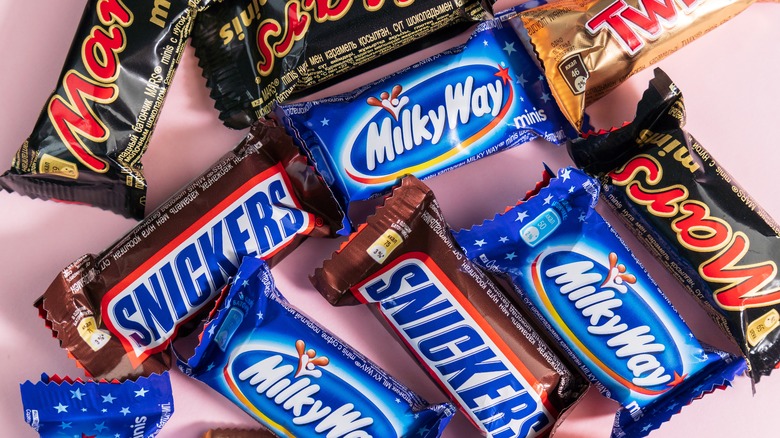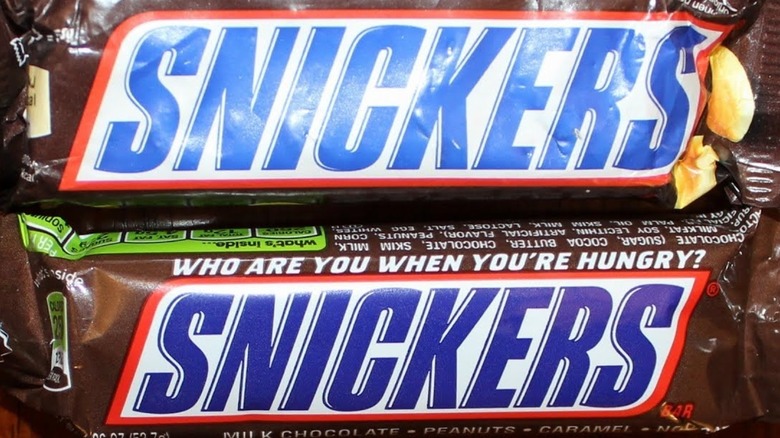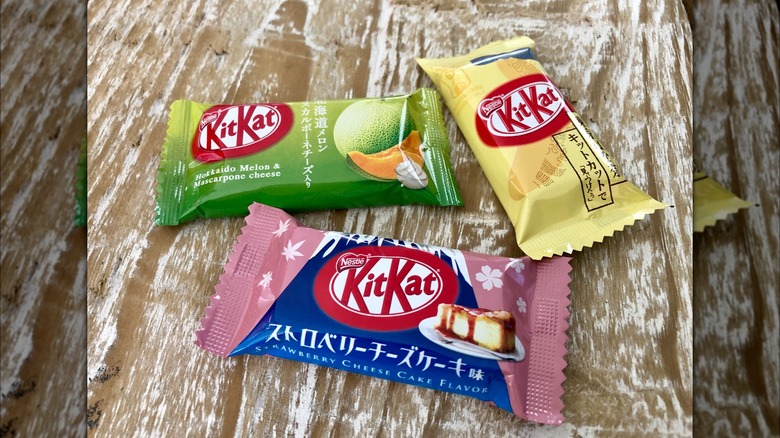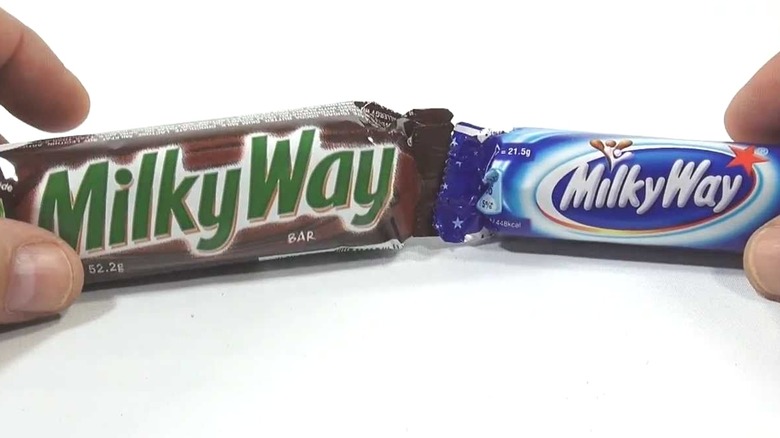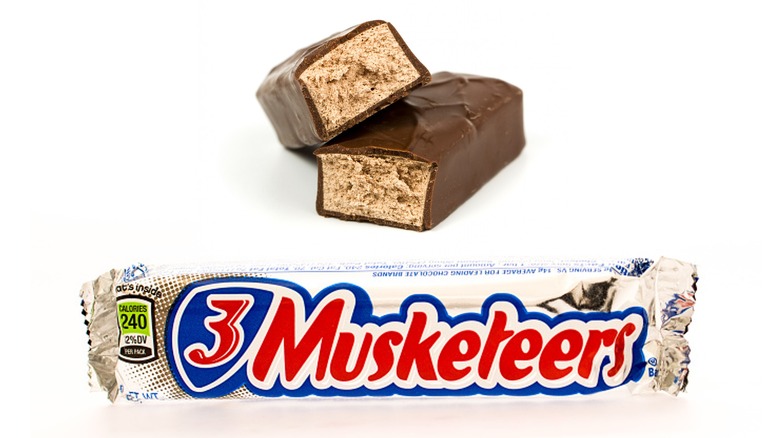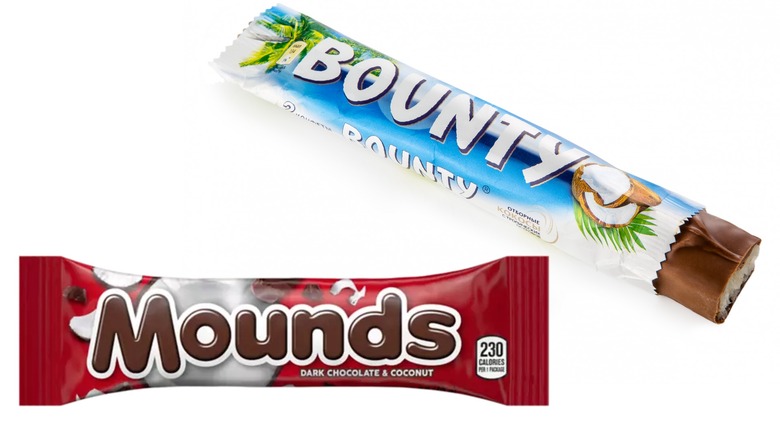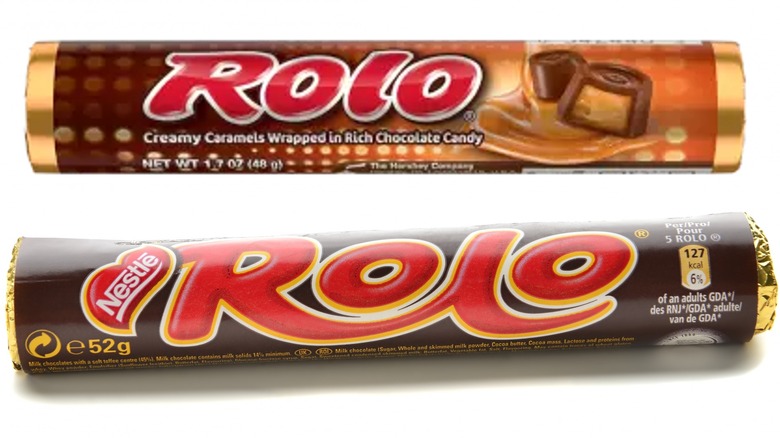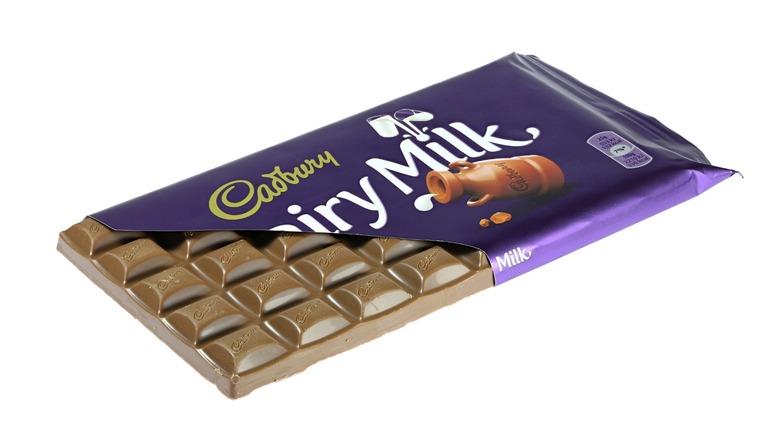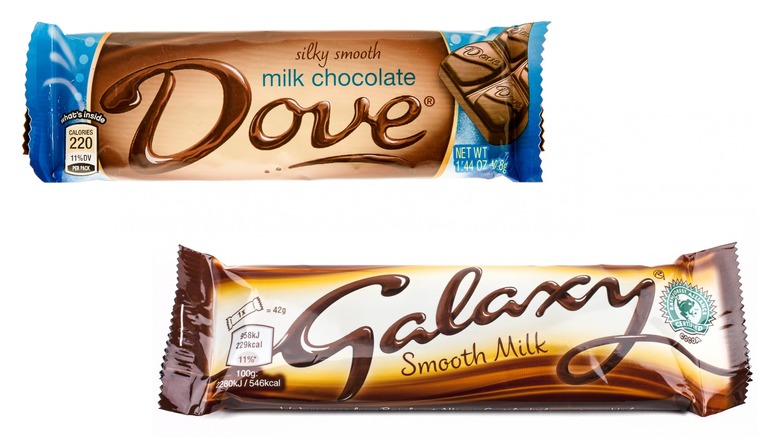8 Chocolate Bars That Are Totally Different Outside The US
Have you ever tried a Snickers bar or Milky Way abroad? If you have, you'll notice some distinct differences from the ones Stateside. The chocolate alone can taste completely different, and Europeans often say US-made chocolate has a foul flavor. On one Reddit thread, Europeans were asked their opinions of Hershey's chocolate, and one person replied, "It gives the same aftertaste as vomiting." It's a strong choice of words, but not entirely off base. You see, American manufacturers use butyric acid — a chemical naturally present in the digestive tract — to stabilize milk used in chocolate. This method is known as the "Hershey Process." For many of us Stateside, this process simply adds a slight tanginess we've come to love in domestic chocolate brands.
However, the differences go far beyond one ingredient. If you wander into foreign stores, you'll see candy bars that resemble American products but in different sizes, shapes, and packaging. And if you bite into one, you'll be surprised by the unique flavors ... it might even be a different candy bar altogether! If you're wondering which chocolates we're referring to, keep reading. We'll explore eight chocolate bars that are completely different outside the US. And as we unwrap each, the fascinating secrets behind these differences will be revealed.
1. Snickers
Hungry? Why wait? You can eat Snickers almost anywhere in the world. However, don't expect this chocolate bar to be the same everywhere you go, particularly in the UK. In fact, the Snickers bar used to go by an entirely different name in this country. Until 1990, it was called a Marathon – and the differences don't end there.
In the States, we sell a wide variety of Snickers, and the standard bar is 1.86 ounces. The UK has a smaller range of Snickers sizes, and the standard bar is also lighter, at 1.69 ounces.
Side by side, a standard UK Snickers appears shorter and thicker. But does it actually taste different? According to an Insider Food taste test, there was a "stark difference," with the food critic preferring the UK version by a mile. They described the chocolate as "way smoother, way creamier, and way more flavorful." Surprisingly, the peanuts were also "more pronounced."
Some differences could be, in part, due to chocolate regulations in each country. According to UK legislation, milk chocolate must have at least 25% cacao mass, whereas, in the States, the FDA says milk chocolate must contain no less than 10% chocolate liquor.
2. Kit Kat
Kit Kat is a household name in the States, but in Japan, it's a whole culture. The Japanese have affectionately dubbed Kit Kats "kitto katto." This catchy nickname sounds very similar to the local expression, "kitto katsu," meaning "you shall surely win." So what do the Japanese do before a job interview or big exam? Buy a Kit Kat, of course! But the consumption of these sweets isn't confined to testing time.
Kit Kats are widely loved in Japan. In Tokyo, you'll even find Kit Kat Chocolatories, where you can build your own Kit Kat bars. You'll choose the chocolate and the toppings, layer your creation and smooth it to perfection. Within the country, you can also buy Baked Kit Kats, which are cooked in a toaster oven for two minutes. But don't go popping just any Kit Kats in the oven. Baked Kit Kats are specifically designed for this purpose and come out pipping hot with a crispy golden shell.
As you can see, the Japanese are coo-coo for Kit Kats, and they aren't shy about funky flavors either. In fact, there are over 200 flavors of Kit Kats in Japan, from green tea to wasabi. And some flavors are only sold regionally, reflecting their local surroundings and making excellent souvenirs. So if you're planning a trip to Tokai, try the azuki Kitto Katto, a sweet red bean-flavored Kit Kat that is the region's specialty.
3. Milky Way
A Milky Way hits the spot when you want a chocolate bar with soft nougat and chewy caramel. While you can find Milky Way bars abroad, there are some significant differences between the two. The American Milky Way comes in a brown and green wrapper. Abroad, the wrapper is blue and white — which should be your hint that these two bars aren't the same at all. And if you bite into the global Milky Way, you're in for a startling surprise because this chocolate bar is missing a key ingredient: caramel.
Americans have difficulty imagining the Milky Way without its caramel layer. Stateside, you'll even find Milky Way Simply Caramels, which skip the nougat altogether. But the global Milky Way consists of just a light, fluffy nougat covered in milk chocolate. It's so light, in fact, that a Twitter post claims, "A European Milky Way chocolate bar will float in milk, but the American version will not."
If you prefer the caramel version, just buy the international Mars bar. It might have a different name and packaging, but it comes with all the essential ingredients of an American Milky Way, including caramel, of course.
4. 3 Musketeers
3 Musketeers is a sweetened, whipped nougat bar covered in chocolate. It was given the musketeer moniker because it originally consisted of three chocolate-covered nougat bars in distinct flavors: chocolate, strawberry, and vanilla. However, sugar rationing during WWII changed the 3 Musketeers since the Mars Company was forced to focus on just one flavor — the fan-favorite chocolate.
But strolling down foreign candy aisles, you won't find 3 Musketeers at all. Because in many countries, including Europe and Canada, a 3 Musketeers is packaged as a Milky Way. While some people say they're basically the same thing, others disagree. One Reddit user explains, "The European (at least the British) Milky Way has a milky flavored whip in the center, not chocolate. To my knowledge, there is no direct translation of the 3 Musketeers bar."
However, the two chocolates do bear some similarities. Both have a fluffy, malt-like filling that, when frozen, resembles a milkshake. So if you're craving the simplicity of a 3 Musketeers abroad, go for a Milky Way.
5. Mounds
If you love chocolate and coconut, you're well-acquainted with the Mounds bar. Produced by Hershey's, Mounds are sweet coconut candies covered in rich dark chocolate. Its sister bar, Almond Joy, is the exact same candy but with the addition of almonds. However, you won't find either of these sweet treats in other countries because Hershey's foreign competitor, the M&M/Mars Company, produces its own version.
Rather than Mounds, stores in Canada, Australia, and the UK sell Bounty bars. This chocolate-covered coconut treat includes milk chocolate and dark chocolate versions. So if you're hankering for a Mound Bar abroad, you'll have to buy a Bounty dark chocolate instead.
However, there are some key distinctions between the two. Mounds come in a bright red wrapper. A milk chocolate Bounty comes in blue packaging, although dark chocolate Bounty does have a red background. Surprisingly, Mounds is smaller at 1.75 ounces, while Bounty is about two full ounces.
Both packages naturally feature a coconut, and the bars look almost identical once unwrapped. But when it comes to flavor, a Medium blogger writes, "To me, the BOUNTY DARK tastes sweeter than MOUNDS. Even its dark chocolate coating tastes sweeter than the MOUNDS dark chocolate coating." Since these bars sound so similar, they're worthy of a blind taste test. But unfortunately, you'll have to go Bounty hunting abroad to do so.
6. Rolo
Do you love anyone enough to give them your last Rolo? This question — and the candy's catchphrase — plagues Rolo fans both at home and abroad. But if you're unfamiliar, Rolos are caramel candies drenched in rich chocolate, and one bar contains a stack of cylindrical chocolates that are easy to share — if you dare.
The Rolo candy was launched in 1937 in England and is currently sold under the Nestle brand. But in 1969, the Hershey Company bought the rights to manufacture Rolo in the United States. Now, we have two almost identical candies by the same name — "almost" being the key word. Both packages contain eight bucket-shaped candies. However, the American Rolos are taller, and the chocolate coating appears darker than its UK counterpart.
But how do they match up in taste and texture? The British Candy Connoisseur breaks down all the delicious details, describing that, "The Nestlé version is softer, stickier, more golden in appearance and has a buttery quality to it. Hershey's caramel is more firm in texture and sweeter in taste and lacks the silky, milky notes of its European counterpart."
7. Cadbury Dairy Milk
Cadbury Dairy Milk originally hails from England. But in 1988, the Hershey Company gained the rights to make Cadbury chocolates Stateside. Ever since, the differences between the two have been hotly debated.
In a New York Times interview, an unsuspecting Brit experienced this difference first-hand while living in America: "One day I was eating a bar of Cadbury Dairy Milk, and I thought, this has absolutely no flavor," he said. "I looked at the label and saw it was made by Hershey. I was outraged." Per Insider, another British Cadbury fan also preferred the UK Dairy Milk, noting that it was "far superior to the US version" because it was "smoother and creamier." They felt the US Dairy Milk was crumbly and had a bitter aftertaste.
But is the preference purely patriotism, or is the British version really better? Unfortunately, a taste test isn't in the cards because Hershey has banned the import of British-made Cadbury to the United States. So unless you can get your hands on some Cadbury contraband, it shall remain a mystery.
8. Dove
Dove, the "silky smooth" chocolate brand, is known for having an extra rich and creamy texture. But what many people don't know is that Dove has a long-lost twin. Across the pond, Dove chocolate is known as Galaxy.
When you put the two chocolate bars side-by-side, it all makes sense. Although they have different names on the wrappers, they're written in a dark brown cursive font, resembling a chocolate ribbon. And if you read the packaging, you'll notice both brands share the same parent company: Mars.
Galaxy was first manufactured in the UK but is sold in Ireland, the Middle East, India, and Australia. Dove, on the other hand, is primarily sold in the United States. However, they're not entirely identical. While some people can't tell them apart, others immediately notice the difference, with one YouTube channel Magenta Otter Travels claiming Galaxy is creamier than Dove. But as far as American chocolate goes, this might be as close as you'll get to the British standard.
Both brands sell dark and milk chocolate, but Galaxy bars also come in Smooth Orange, Cookie Crumble, and Honeycomb Crisp. However, Dove really sets itself apart with its Promises, bags of bite-sized chocolates in flavors like dark, milk, peanut butter, and mint swirl. Inside each wrapper are heartfelt — albeit cheesy — quotes along the lines of "Live, love, Dove" or "Book the flight!" And after all this chocolate talk, we just might take that last piece of advice ... and try some foreign chocolates in the process.
